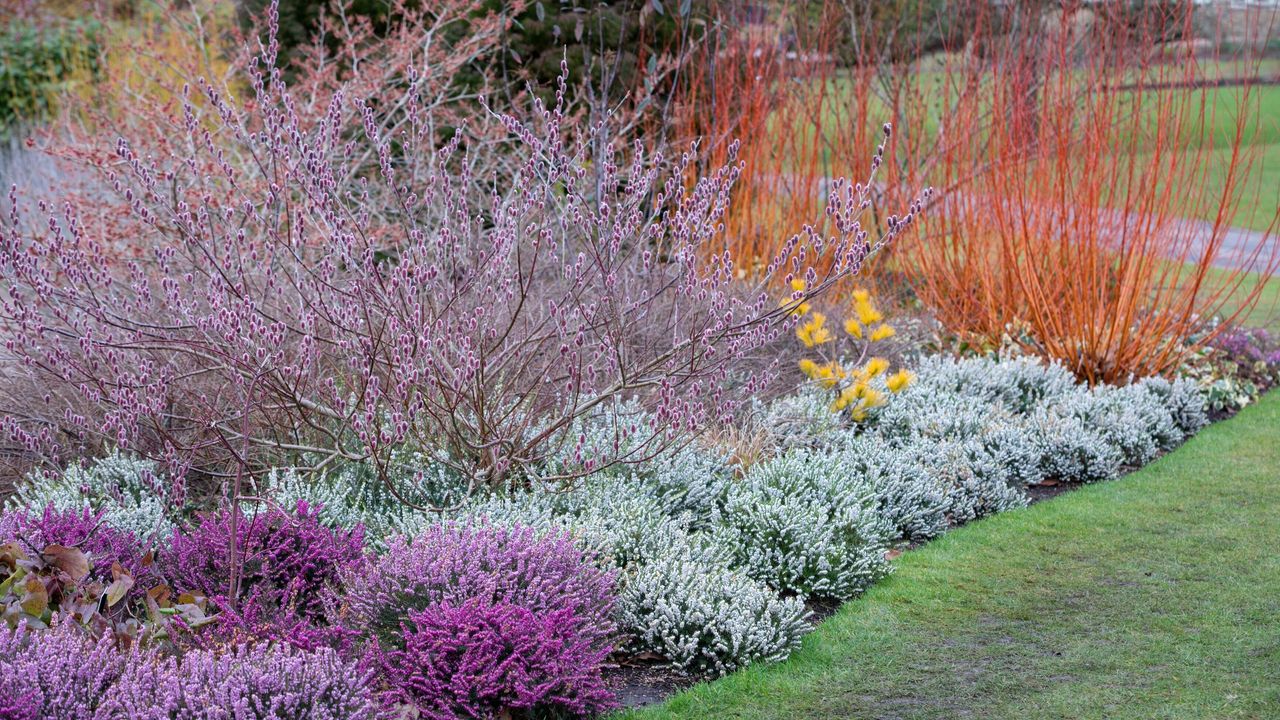
Gardens can look a little drab in the winter, especially when you live in a region with distinctive seasons. Once the temperature has seriously dropped, the spectacular crimson shades of deciduous trees have disappeared, and pretty perennials have gone into dormancy, the outside often looks bare and bleak. Yet thankfully, that doesn't have to be the case.
With a number of modern garden ideas and enduring techniques brought up-to-date, it is possible to achieve color and interest in your yard, even in the depths of winter.
From glossy evergreens, beautiful berries, and winter blooms to decorative features, spectacular stems, and strategies that attract pollinators, there are numerous ways to add quiet beauty and seasonal color when much of nature is dormant. Discover what garden designers and landscapers do to create the perfect winter yard.
1. Create a Focal Point With Striking Winter Planters
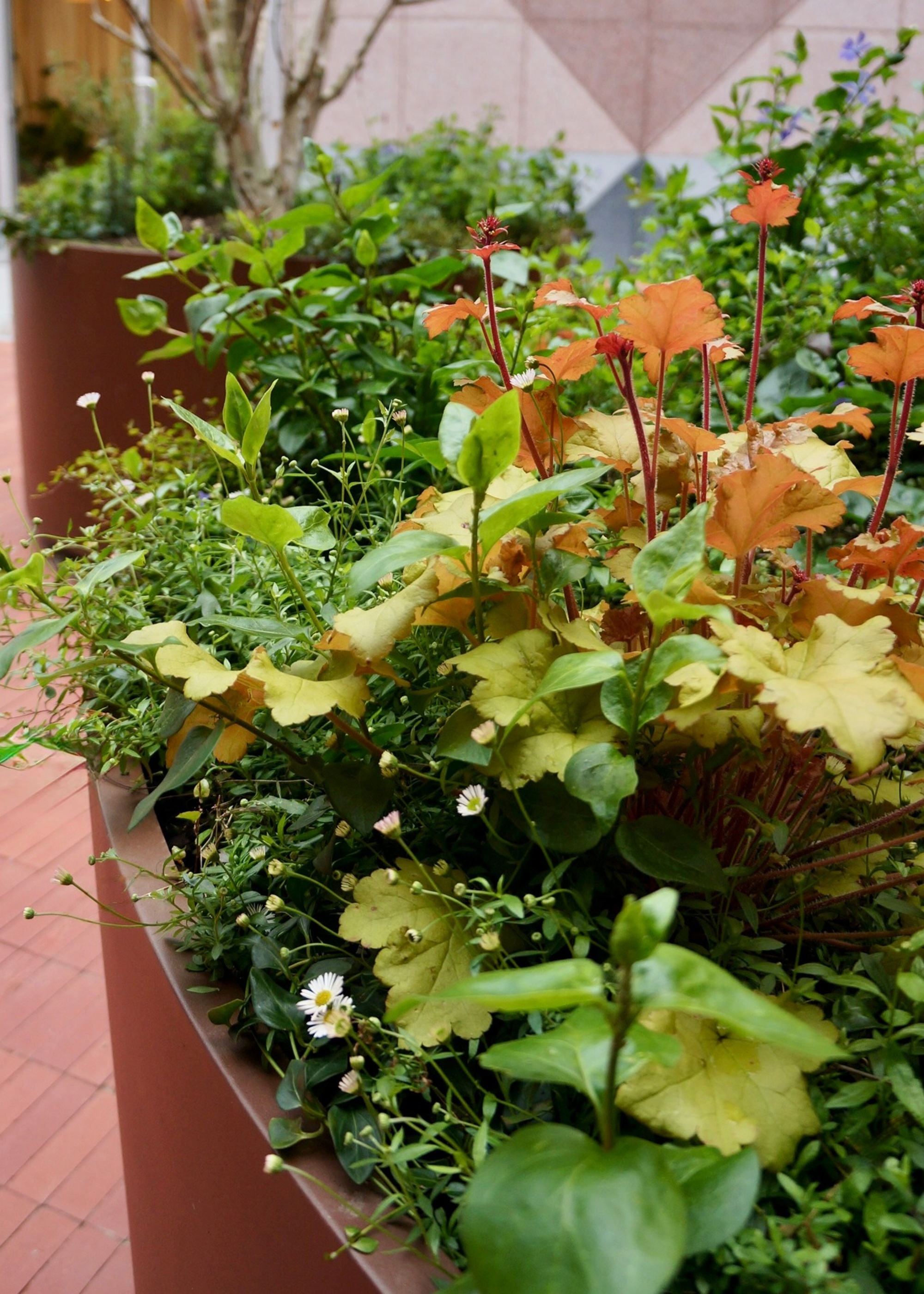
If you're wondering whether it's too late for container gardening, be assured that it's not. Although your pots will obviously need to be filled with hardy plants that can withstand a frost or winter chill, it's still possible to create a focal point or feature with planters. Consider evergreens – or for more color – foliage plants with interesting leaves, such as Heuchera.
"Large planters can transform even the smallest courtyard or patio into a vibrant winter haven," says Gina Taylor, garden designer and founder, East London Garden Design. "Group pots near the house or by windows so you can enjoy them from indoors during colder days."
Gina continues: "Fill them with evergreen scented winter flowering shrubs like Sarcococca confusa ‘Sweet Box or Mahonia ‘Soft Caress’. Add colorful foliage plants like Heuchera ‘Marmalade’, ‘Fire chief’ or ‘Green Spice’, and plants with winter flowers or striking stems. Layer your planting with taller structures in the center (like small trees or Cornus ‘Winter flame’ for stem colour) and trailing plants around the edges. I particularly like Vinca Minor for its little star-shaped flowers."
The expert says autumn is an ideal time for planting your winter containers. "Use a good-quality, free-draining compost mix and top with mulch or decorative bark to protect roots from frost," she adds.
Inspired by Moroccan stone decor, this Sienna Cement Outdoor Planters from Pottery Barn is perfect for all your container gardening needs.
If you're dealing with a small garden then this set of three tall planters will add depth and style to your space in no time.
Add pattern to your outdoor planter this this stunning jade find from OKA. The planter depicts a stunning Chinese landscape and makes for the perfect addition in any outdoor area.
2. Line Pathways With Colorful Winter Flowering Plants
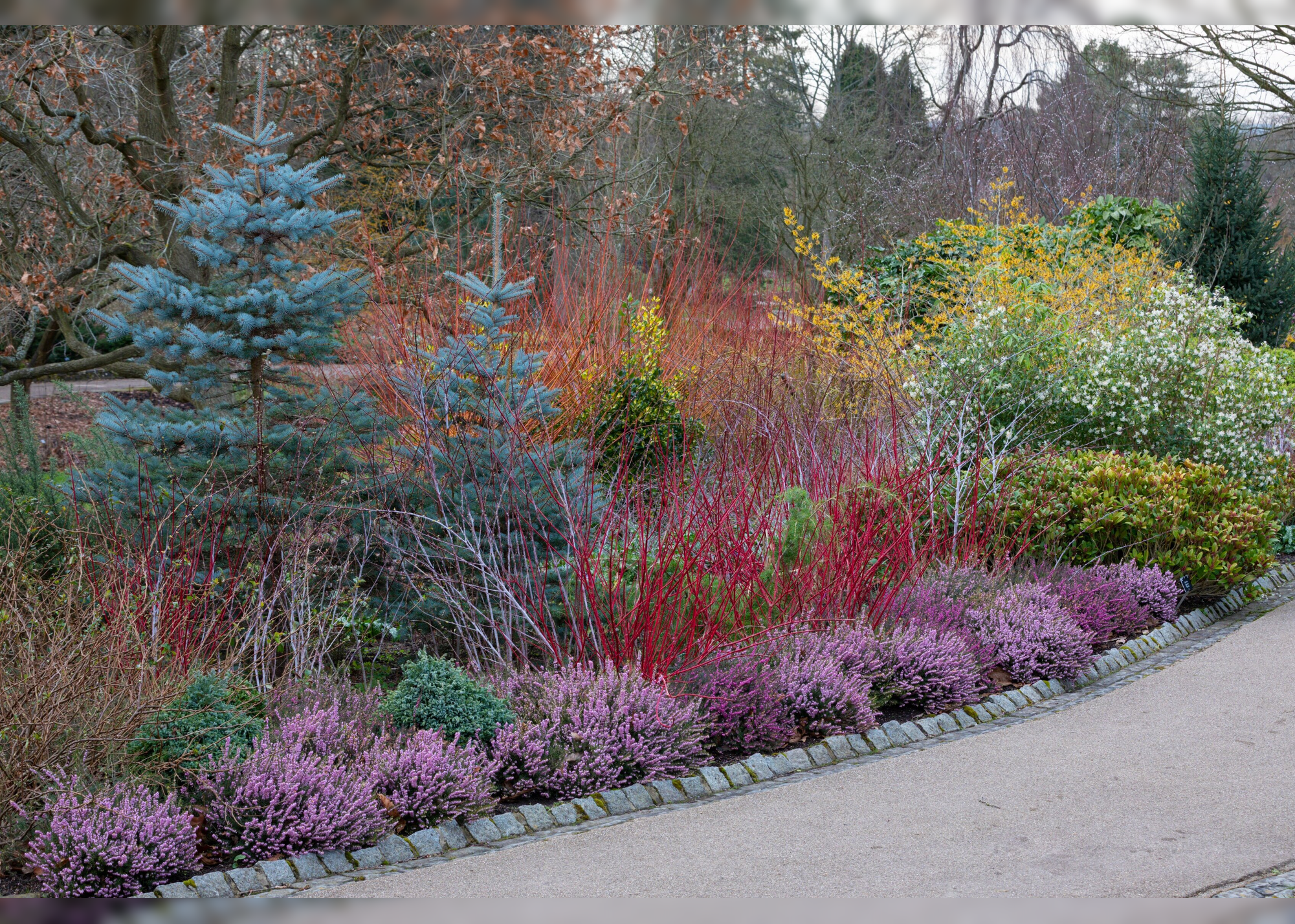
It might seem like everything is hibernating, but various winter-flowering plants can thrive in the colder months. Plant them beside pathways or in flower beds and borders to give your garden a cheerful lift.
"Winter gardens don’t need to be dull," says Gina. "Winter flowering plants like Hellebores, Skimmia, Daphne, Camelia, and Mahonia bring welcome bursts of color and are invaluable sources of nectar when little else blooms.
"Position winter-flowering plants where they’ll catch low winter light — near pathways or doors where their scent and colour can be appreciated. Pair Mahonia’s bright yellow blooms with deep green evergreens for contrast," Gina continues. "Plant in autumn (or early spring) in well-drained soil and add compost and mulch annually to retain moisture and protect roots from winter frosts."
Garden designer Paul Studholme, founder of The Plant Hunter, is a huge fan of winter-flowering plants too and highlights some of his favorites. "There are many different winter flowers such as Witch Hazel, Heather, Hellebores, and of course winter bedding plants. If I were to choose one to stand out from the rest, it would have to be one with a strong scent," he says. "The battle would be between Daphne Eternal fragrance and the Edgeworthia chrysantha. Taking into account the interesting shape and unusual stems and leaves, the Edgeworthia would come out on top for me."
3. Keep It Soft, Calm, and Minimal With Evergreens and Grasses

Not everyone loves bold color or florals in their garden, whatever the season. If you prefer a more minimalist palette or architectural style, consider texture and soft green tones in the form of ornamental grasses and evergreens. These make for the perfect architectural plants for winter gardens.
"For a serene, textural winter garden, grasses and evergreens are your best friends," says Gina. "Stipa tenuissima retains its feathery form throughout winter, adding gentle movement, while compact conifers or dwarf pines provide year-round structure.
"Choose contrasting shapes and forms of plants and group them in 3’s or 5’s for a more natural look. Mix fine grasses with architectural evergreens and silvery foliage plants for a harmonious, natural look," Gina adds. "Avoid over-planting — winter gardens benefit from breathing space and simplicity. Grasses ideally should be planted in late summer to establish before frost; evergreens can go in during autumn or spring."
"I always aim to use some evergreen shrubs in my landscaping," says Laura Janney, CEO, The Inspired Garden Masterclass. "I usually place them in the background and near the entrance. Some of my favorite shrubs that keep their leaves include Euonymus, Holly, Skip Laurel, Rhododendrons, Boxwoods, and Blue Spruce."
"Grasses are a great option too," adds Paul. "Especially Calamagrostis Karl Forester and Pennisetum Hamel."
4. Let Nature in by Leaving Seed Heads
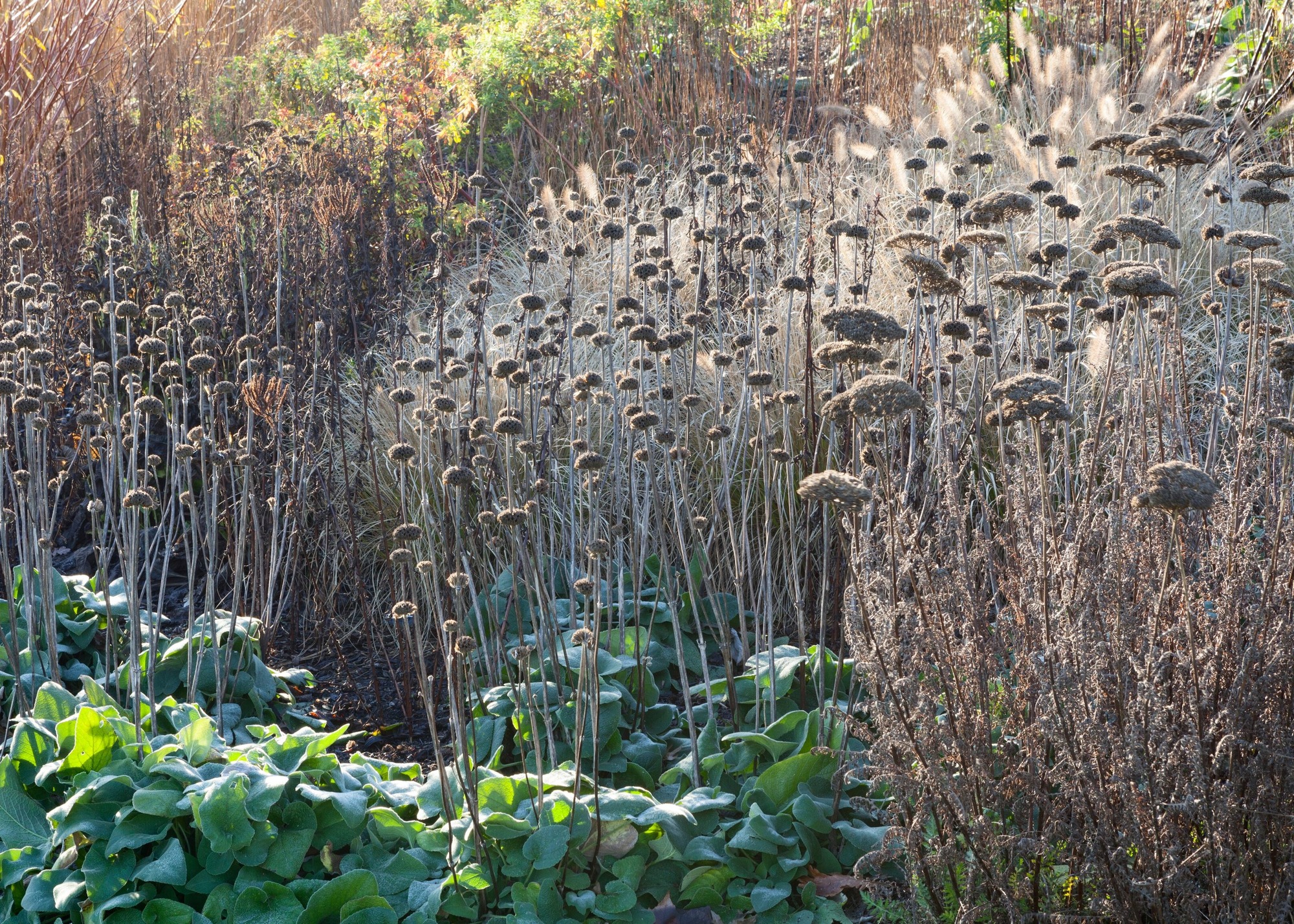
It's easy to overdo it when winterizing your backyard, but if you can leave some plants to seed, it will add interest and life to your outside space. Stiff, manicured gardens not only look old-fashioned, but they do little for nature. A modern approach is to let things look a little 'wild'.
"Resist the urge to cut everything back and ‘tidy up'," says Gina. "Leaving seed heads, fallen leaves, and small piles of logs creates essential habitats for insects and birds during winter. The result is not only ecological but also visually appealing — dried flower stems and sculptural seedheads catch frost beautifully.
"Stack logs neatly to form insect hotels and let perennial stems stand until early spring. Combine functionality with style by incorporating these elements into the landscape design. Focus on habitat creation — autumn is the best time to set up log piles and leave natural debris in place."
"A fantastic option for seed heads with the most amazing geometric shapes is Phlomis russeliana," says Paul. "Let them flower in the summer, form the beautiful dried flower heads, and then cut them hard back in the spring around April time."
5. Choose Interesting Stems and Barks

Winter-blooming plants aren't the only route to color and vibrancy in the cold season. Trees and shrubs with interesting bark and stems can introduce color in striking and unexpected ways.
"I'm a huge fan of a well-planted winter garden," says Paul. "If the right plants are chosen, they will look amazing and really stand out bright at a time that can otherwise be a little bleak and dull. For me, the best winter planting impact comes from using a well-choreographed mix of several elements: Stem and bark colour, seed heads, and winter flowers.
"A classic and an obvious option here would be Betula Jacquemontii with its beautiful pure white bark and, of course, Dogwoods with yellow and red stems, a particularly good example being Cornus alba Sibirica. My favourite, though, would have to be Prunus serrula, the Tibetan Cherry with beautiful shiny copper bark."
Paul says all of these species can be planted most times of the year, but warns to "avoid very dry periods and they should grow well, if in the appropriate position and soils. Just make sure they get plenty of water during the growing season, and you should get a fantastic display to lift your garden in the winter. Something I particularly love to do is to combine dried seed heads with vibrant stems; together they can look amazing."
6. Plan a Winter-Blooming Woodland Garden
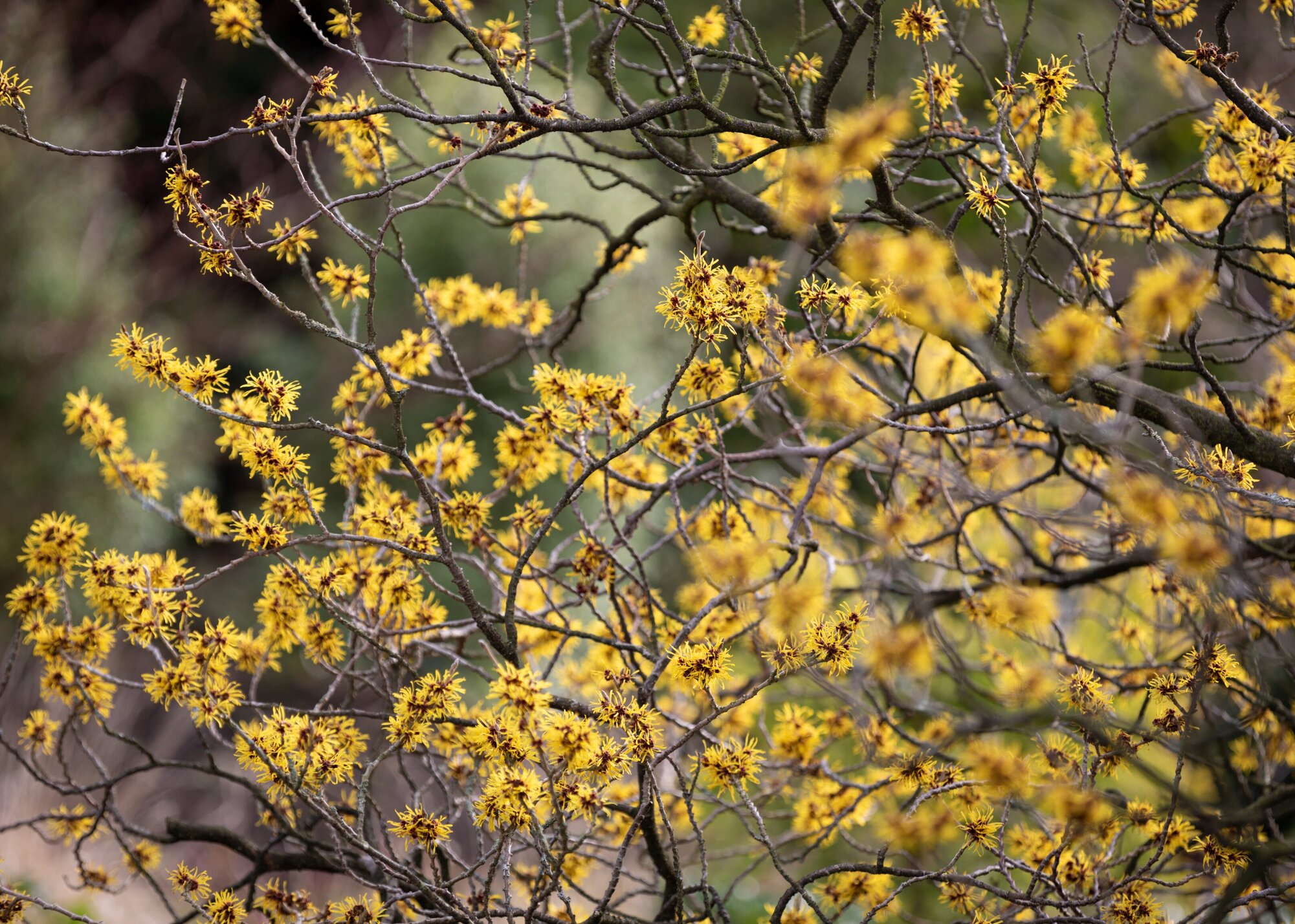
If you'd rather leave riotous color to spring and summer, but prefer something a little bolder than evergreens and ornamental grasses, consider woodland plants. Here you'll find plenty of warm tones with winter-flowering shrubs such as Witch Hazel (Hammamelis), and Hellebores, that will grace your yard with softly-colored blooms in late winter. Both of these plants and many other woodland species can be planted between October and April (although not if the ground is frozen or waterlogged).
"There is a bevy of gorgeous fall and winter blooming plantings that can add interest during these otherwise dreary months," says New York-based landscape designer, Kat Aul Cervoni, founder of Staghorn Living. "Many of these plants are well-suited for part shade woodland gardens, so this is the ideal environment for this type of planting palette to thrive in. The plants I like to use in this type of garden include Hellebores, which have the benefit of having evergreen foliage, while also being a winter-blooming perennial, bonus points for being extremely tough and cold hardy."
Additionally, Kat says she loves including Hammamelis — Hammamelis virginiana for a late fall bloom and Hammamelis x intermedia for a winter (and fragrant) bloom. She continues: "Sarcococca is another part-shade evergreen scented shrub that offers winter blooms. And if you’re zone 7 or higher, Edgeworthia is a must for a stunning winter display with fragrance as well. Finally, don’t forget some late winter bulbs such as snowdrops, which can break through snow to bring charm to the winter garden."
7. Make It Bird-Friendly With Winter Berries

Interest in your garden comes in many forms, and birds bring color, movement, and charm. Our feathered friends will be on the hunt for food, water, and shelter, whether native or migratory species, and many love winter berries. These plants are a win-win, providing pops of color in the landscape and sustenance for wildlife. Don't forget to include a bird bath, so they can drink and bathe too.
In New York & New Jersey Month-by-Month Gardening, author Kate Copsey tells us. "Shrubs with Winter Berries, such as Holly, beautyberry, viburnums, coralberry, winterberry, cotoneaster, pyracantha, and yews, attract birds with their berries, but they also shelter birds from hawks and storms. The dense cover from conifers is also a perfect shelter for birds, and many tall perennials make good landing places too. Anise hyssop, sedums, coneflowers, and black-eyed Susans are some of the more common perennials that birds can perch on."
Kate continues: "Sunflower heads are another attraction, and if left on the plants at the end of summer, finches and other birds enjoy the seeds as well as just sitting on them.
"Add a bird bath and you will see the birds drink and sometimes bathe in the water," says Kate. "Having a garden that attracts birds gives indoor gardeners something interesting to watch all winter,"
8. Introduce Festive Accents to Containers During the Holidays

As you've seen, nature can provide plenty of color in our backyards even when the temperature has plummeted. For an extra seasonal lift, Laura Janney decorates her outdoor containers with festive touches for the holidays. Try Laura's mix of evergreens, attractive branches, and pretty baubles for seasonal decor outdoors.
"I like to incorporate festive elements into my containers like lotus pods, pine cones, eucalyptus, or berries for a natural, yet colorful, festive look," says Laura Janney, CEO, The Inspired Garden Masterclass. "Alternatively, you can add some sparkle to your container by using seasonal picks (like ornaments) from your local craft store."
She adds, "A mix I like to use is Noble fir: these beautiful, thick, dark green branches make a solid base and fill out the container. Cedar, as it's thin and floppy and will softly cascade over the sides of the pot if you place it along the outside edge. The flat, scale-like needles also add a pretty, delicate touch."
FAQs
Should I Put Furniture Away in the Winter?
If you live somewhere with wet, cold, or windy winters, preparing your outdoor furniture for winter will ensure it lasts longer. Steel, aluminium, and teak are fairly hard-wearing, but timber should not be left on wet grass, or it will rot.
"If you have the space, move furniture into a shed, garage, or under a covered area where it will stay dry," says Gina. "When that’s not an option, invest in breathable waterproof covers to keep out the rain, while still allowing air to circulate. Wicker and rattan pieces should be kept as dry as possible."
Ensure each piece is clean and thoroughly dry before putting it away, as even a little trapped moisture can lead to mildew over the winter.
"Don’t forget the soft furnishings: wash removable cushion covers and store them somewhere dry, ideally in airtight containers. If furniture has to stay outside, lift it slightly off the ground," adds Gina. "A little preparation now ensures that when spring returns, your outdoor space is ready to enjoy again with minimal effort."
As you can see, there is much you can do to make a modern garden attractive, even during the cold winter months. Mix different ideas according to your taste, style, and weather conditions in a color palette that appeals
"A great planting combo is to mix the white stems of the Betula alongside the bright red of the Cornus, then add some pops of feather flowers with a tall ornamental grass dotted between," says Paul. "This will give you a lovely contrast of colour and texture, when it's otherwise gloomy outside."







